Where did E1b1b Originate and Expand From?
The debate as to whether haplogroup E is Eurasian or African in origin is still in place - but still needs more research. However, a recent June 2019 study that shows new evidence that DE (the ancestral lineage to E) developed independently in Africa from an ‘almost’ extinct ancient group of people that are mostly related to present day West Africans. Although DE itself is very rare, and has only been reported in West Africans and Tibetans, nonetheless, the DE found in Nigeria appears to be ‘deeply divergent’. This means it may have originated there.
The debate as to whether haplogroup E is Eurasian or African in origin is still in place - but still needs more research. However, a recent June 2019 study that shows new evidence that DE (the ancestral lineage to E) developed independently in Africa from an ‘almost’ extinct ancient group of people that are mostly related to present day West Africans. Although DE itself is very rare, and has only been reported in West Africans and Tibetans, nonetheless, the DE found in Nigeria appears to be ‘deeply divergent’. This means it may have originated there.
**Full study:**
The new study pretty much confirms that both DE and E are African in originnot Eurasian. Also, both E1b1b and E1b1a were born in Africa, however, some E1b1b individuals left Africa to the Near East at some point. Some later returned back to Africa as admixed. Others stayed in the Middle East and others migrated to West Eurasia and Southern Europe.
E1b1a, on the other hand, is said to have never left Africa but was reported in 6% of Natufian samples. As for E1a (the parent of E1b1b and E1b1a), it seems to have never left Africa at all. Or it may have left Africa and became E1b1b after admixture with West Asians. More research is needed. To make things clearer;
- DE (the ancestors of both the D and E clads) is mainly found in Nigeria (that is, unless the Tibetan “DE”, once re-analyzed, turns out to be something else).
- D0 is found both in West Africa (deep in the African continent) and in the Middle East (Saudi Arabia and Syria).
- D is (so far) is found in Asia.
- E1a/E-M132, a very basal branch of E older than E1b1b, is exclusively African and is commonly found for instance among the Dogon, and other similar peoples of Mali/the West African savanna-like the Diola, Papel, and Manjak—who, like the Dogon, are fully sub-Saharan.
- E1b1b branch of E is found in both Afric and Eurasia but is very likely to have come from North or East Africa
- E1b1a is mostly African - but was also found in 6% of Natufian samples.
So to sum up, the whole E family is mostly found in Africa (with the exception of the single E1b1b clad that was probably born in Africa but left the continent at some point, and returned back as admixed thousands of years later).
Regardless of where E1b1b originates, the physical characteristics of the ancient E1b1b carriers were certainly not affiliated with many of its present-day carriers who possess a much larger amount of Neanderthal DNA, who carry the light skin depigmentation gene SLC24A5 and who are lactose tolerant.
In terms of genetics, all modern-day E1b1b carriers are related to the first E1b1b carriers, however, in terms of physical traits and phenotype, most have no resemblance at all.
Who is a Eurasian?
Important to note that the word ‘Eurasian’ does not equate to a ‘non-black’ person. Many genetic scientists use the word ‘Eurasian’ to reference the ancient people who stepped out of Africa.
Of course, there are many people who have an agenda when using the word ‘Eurasian’. They use semantics to distance black Africans from the first Eurasians but it all backfires because Africa carries the ancestral source of all human Y-DNA and there are many NATIVE black Eurasians living in the Middle East and Pacific Islands.
In fact, the Hadza people of Tanzania were the first Eurasians - as confirmed by Harvard Medical School and they are a black African people with Y-DNA Haplogroup B. They were the first people to settle in North Africa along with the Haplogroup A Nilotics.
Haplogroup B also settled in the Middle East, Europe, Asia, and the Pacific Islands probably around 65, 000 - 100,000 years ago and their genetic fingerprint is found in ALL modern humans.
The Hadza Hunter-Gatherers - The First Eurasians of the Middle East, Europe, Asia, and North Africa - Y-DNA Haplogroup B
Who were the ancient E1b1b Carriers?
As mentioned earlier, all modern humans diverged from a ‘deep lineage’ related to a Hadza type group. To find the first E1b1b carriers, let’s take a look at all the genetic, historical and scientific evidence by deviating through the various haplogroups.
As mentioned earlier, all modern humans diverged from a ‘deep lineage’ related to a Hadza type group. To find the first E1b1b carriers, let’s take a look at all the genetic, historical and scientific evidence by deviating through the various haplogroups.
Let’s first begin with the people found in the Pacific Islands and Asia (Melanesia) who are Haplogroup C - their footprints were traced from East Africa, the same area where the Hadza lived in Tanzania. The Melanesians remained uncontacted for thousands of years. Although both their DNA and hair texture has been slightly altered probably due to heavy Denisovan admixture, they still look ‘African’ in their appearance due to isolation. It is common knowledge that the most isolated tribes who stayed in the Southern hemisphere maintained their ‘African’ appearance (not the DNA).
Melanesians Haplogroup C - With natural blonde hair
Haplogroup C - Orang Asli - Philippines
Haplogroup C - Australoids
We have covered haplogroup B (Hadza) and C (Melanesia/Australoids). Now let’s move on to Haplogroup DE (the ancestors of D and E). Although Haplogroup C isn’t found in Africa, surprisingly DE is found there, amongst the people of Southern Nigeria.
Nigerians/West Africans - Haplogroup DE
DE is also found in Tibet (according to the new studies released- further studies will soon be carried out on the Tibetan DE to ascertain if it was really DE).
D is found amongst the Sentinelese black people in India, as well as the Japanese. E is predominantly found in Africa.
Tibetans - Haplogroup DE
The lack of C in Africa has led many scientists to believe that DE may have come back from Asia to Africa as DE is also found in Tibet. This is very possible.
However, the new 2019 study I quoted at the start reveals a newly discovered Haplogroup named ‘D0’ which is a deeply rooted, African-based branch of the DE lineage which is found in West Africa, Syria and Saudi Arabia. However, although D0 was found in Syria and Saudi Arabia, they lack the deeply divergent DE lineage found in Nigeria. This new discovery suggests that E may have actually come from deep inside Africa even as far as West Africa. But most agree that it probably came from North East Africa.
If it came from outside of Africa, it likely came from a population in the Andamese Islands who also carry a deep rooted D lineage
Andamanese people
How Can Y-DNA Haplogroup E be African if Haplogroup C is not in Africa?
They explain in the study that;
They explain in the study that;
Two separate migrations were made out of Africa within a short time period. The Hadza/Mota type haplogroup B people were the source of both. The first migration was to Asia. After B left Africa, they mixed with archaic humans in Asia that led to the emergence of (C). Within a short time after that, the B carriers that didn’t leave Africa mixed with another C group in Africa (CT) which led to the emergence of (DE) which also left Africa at some point.
However, not all the CT carriers left Africa. One dominant group remained in North East Africa, mixed with older humans, giving brh to DE and became the ancestor of the present-day Niger-Congo and Bantu farmers.
The study confirms that both DE and E were born in North East Africa and all the evidence is looking like Haplogroup E1b1b also developed in Africa.
What Other Evidence is There About the E1b1b Carriers?
The recent 2018 study on the 15,000-year-old ancient remains of the Iberomarusians in North Africa that showed that the ancient E1b1b individuals had the following characteristics;
The recent 2018 study on the 15,000-year-old ancient remains of the Iberomarusians in North Africa that showed that the ancient E1b1b individuals had the following characteristics;
- They carried little to no Neanderthal admixture. Heavy Neanderthal/Denisovan admixture is a sign of Asian/Australoid heritage - Tibetans, Australian aborigines and some Melanesians carry on average 4-6% Neanderthal/Denisovan ancestry (the highest in all humans). However, the tiny amount carried by the ancient remains of the Iberomarusians was on par with the amounts currently found in Sub-Saharan Africa. This may suggest much closer links to Africa. However, this doesn’t rule out the fact that an Australoid-type (Neanderthal + African mixed) people inhabited the Middle East at some point. There were lots of back and forth migrations into Africa.
- They lacked the SLC24A5 Indo European depigmentation genes - certainly, they were not white like present-day North Africans who carry those genes. This has been proven by the Taforalt study.
- Their DNA was partially related to the ancient Natufian remains found in the Levant and were most likely ancestral to the Levantine Natufians.
- They had the same burial practices as found in Ancient Egypt - the dead were buried facing the West. So there is a clear connection with the Taforalt population and the ancient Egyptians.
- They carried the Hadza genetic component as well as some West Eurasian ancestry. This has been proven by the Taforalt study which showed 5% Hadza ancestry.
- Most importantly, they were lactose intolerant which is a common trait of Sub Saharan Africans. Again, this has been proven by the Taforalt study.
- Another recent study from the Dzudzuana caves in Georgia revealed that West Africans (represented by the Yoruba) carry 12% DNA passed down from a Taforalt/Iberomarusian related group (one branch of the Ancient North African (ANA) DNA is now extinct and their ghost presence only shows up in West African DNA samples).
The thing is - if West Africans carry an ancient North African DNA but show no signs of the SLC24A5 depigmentation genes found in present-day North Africans, the ancient North Africans evidently did not look like the present. How can this be? We’ll find out later, but first, let’s see how the ancient E1b1b carriers compare to the present day carriers.
How do these findings compare with the present-day E1b1b carriers?
Although the modern-day North Africans from Morocco have managed to maintain the male Y-DNA of their ancestors, they now carry higher amounts of Neanderthal DNA which their Taforalt ancestors did not carry.
Although the modern-day North Africans from Morocco have managed to maintain the male Y-DNA of their ancestors, they now carry higher amounts of Neanderthal DNA which their Taforalt ancestors did not carry.
In addition, modern-day North Africans are mostly of a light-skinned West Eurasian/Indo European descent, but as previously stated, the ancient Taforalt remains were mostly of a dark-skinned Ancient North African (ANA) DNA mixed with a West Eurasian MtDNA, ‘In contrast, present-day North Africans have minimal ANA-related contribution'
This means that somewhere down the line, North Africans have received a heavy amount of migration from West Eurasia or Europe that has gradually displaced the ANA element. So, clearly, the ancient North Africans would not have looked physically like the modern population.
What else did the study find?
The study on the Taforalt remains in Northern Morocco also revealed that these ancient individuals did not carry the light skin depigmentation gene SLC24A5. The depigmentation gene is only 8000 years old and has been in Africa for around 3,000 - 5000 years and is said to have come from Anatolia (West Eurasia). It wasn’t carried by the Taforalt individuals but it is now overwhelmingly found across the Middle East and North Africa).
The study on the Taforalt remains in Northern Morocco also revealed that these ancient individuals did not carry the light skin depigmentation gene SLC24A5. The depigmentation gene is only 8000 years old and has been in Africa for around 3,000 - 5000 years and is said to have come from Anatolia (West Eurasia). It wasn’t carried by the Taforalt individuals but it is now overwhelmingly found across the Middle East and North Africa).
Quote from the study;
“Phenotypic analysis was performed on four of the Taforalt individuals with higher genomic coverage. The Taforalt individuals tested did NOT carry either of the derived SLC24A5 alleles associated with lighter skin color, the derived OCA2 allele associated with blue eye color, or the derived MCM6 allele associated with lactase persistence. However, they were found to carry the ancestral SLC24A4 allele associated with dark eye color.“
How exactly does SLC24A5 affect skin colour?
The SLC24A5 gene's derived threonine or Ala111Thr allele (rs1426654) has been shown to be a major factor in the light skin tone of Europeans compared to Sub-Saharan Africans, and is believed to represent as much as 25–40% of the average skin tone difference between Europeans and West Africans.
Researchers found that all individuals from the Middle East, North Africa, East Africa, and South India who carry the A111T mutation share a common “fingerprint” -- traces of the ancestral genetic code -- in the corresponding chromosomal region, indicating that all existing instances of this mutation originate from the same person. (This is evidence of a separate migration of white-skinned West Eurasians). Carriers of SLC24a5 spread across Northern and Southern Europe, the Middle East and North Africa in the last 3,000 - 5,000 years.
This means that somewhere down the line, the Ancient black skinned North Africans received those light skin alleles through heavy admixture with a much later migration of Indo Europeans or light-skinned West Eurasians, hence why SLC24A5 is not found in present-day West Africa. West Africans received their ‘North African’ DNA by the ancient group of dark-skinned North Africans that were in Africa 35,000 years before being replaced by the modern ones. The modern ones have inherited the Y-DNA of the ancient ones. Who were these ancient dark-skinned North Africans? Nobody knows. We’ll take a look later at who they might have been; but first, let’s look at the image below.
The image below is of SLC24A5 carriers with dark green being the strongest. Even South Asians and East Africans carry this depigmentation gene - as dark as they are. Only West Africans/Southern Africans and East Asians lack it. Image Source: The Light Skin Allele of SLC24A5 in South Asians and Europeans Shares Identity by Descent
Who were the Iberomaurusians?
Taforalt/Iberomaurusians were half ANA (Ancient North African) and half Eurasian (from an earlier migration of West Eurasians into North Africa).
Taforalt/Iberomaurusians were half ANA (Ancient North African) and half Eurasian (from an earlier migration of West Eurasians into North Africa).
Who were the ancient north Africans?
The Ancient North African population (ANA) was not Eurasian. They were more like the Omotic people of Ethiopia or Mota populations (a type of native black African - native to North-East Africa). They were more or less related to the group that left Africa, settled in Europe and the Middle East, and became the ancestors of Eurasians. However, they were black-skinned and native to Africa. One branch did not leave Africa.
The Ancient North African population (ANA) was not Eurasian. They were more like the Omotic people of Ethiopia or Mota populations (a type of native black African - native to North-East Africa). They were more or less related to the group that left Africa, settled in Europe and the Middle East, and became the ancestors of Eurasians. However, they were black-skinned and native to Africa. One branch did not leave Africa.
Who were the West Eurasians?
The West Eurasian DNA found in the Taforalt/Iberomarusian samples were most likely Eurasians that had returned back to Africa. However, they were black skinned people as SLC24A5 was not found in their genes. Although they were dark-skinned, they would have looked distinct from other black populations due to Neanderthal admixture.
The West Eurasian DNA found in the Taforalt/Iberomarusian samples were most likely Eurasians that had returned back to Africa. However, they were black skinned people as SLC24A5 was not found in their genes. Although they were dark-skinned, they would have looked distinct from other black populations due to Neanderthal admixture.
They were more or less a Cheddar man type people with straight hair and dark skin but didn’t have blue eyes like Cheddar man. These Eurasian females had mixed with ANA men probably in North Africa, the Middle East or Eurasia.
So Are Modern Day North African Mixed with Two West Eurasian Groups?
Yes. The minor West Eurasian component in the Taforalt/Iberomarusian samples lacked the SLC24A5 genes. This proves that they were different from the West Eurasians that arrived in full-blown force 5,000 years ago carrying SLC24A5 in their genes. So, we are talking about two different types of Eurasians - black ones and white ones.
Various waves of West Asians entered Africa, the first being dark-skinned and the latter waves being white-skinned. The vast majority of the ancient North Africans ended up in present-day Mauritania and were settlers in Dhar Tichitt ) before the white-skinned Berbers and Arabs arrived in Africa via Libya.
To get a deeper insight into who the first ancient Eurasians were, I recommend reading a book called ‘Nomads of Mauritania’ by Diane Himpan-Sabatier. This writer has detailed the different waves of migrations that took place. Some of the information in her book is very valuable and on point, but some of her work is out of date as it was written a while back. Since then, various DNA tests contradict her timings.
As described earlier, the first Eurasians were probably more of a Cheddar Man/Australoid/pre-Dravidian or Melanesian type people who lived across Asia, Southern Europe, the Middle East, and North Africa, for thousands of years before being absorbed by the Indo European SLC24A5 carriers who arrived to North Africa 3,000 - 5,000 years ago. This is also supported by the ‘Cheddar Man'theory.
The most prominent were the ancestors of the Bafour people or ‘Pharusians’ whose presence have been recorded in North Africa. They were black-skinned people who are said to have come to West Africa directly from Ancient Egypt 9,000 years ago: They lived mostly in North Africa and had the same burial practices as the Ancient Egyptians.
Some historians say that the Bafour were African in origin, others say they had historical roots in Southern Yemen/Northern Ethiopia or ancient India (but bore no resemblance to present-day Yemenis/Indians who are now mixed with Semitic/Indo European or ancient Iranian farmers). They could have also been related to the Natufians of the Levant.
What did the E1b1b carriers look like?
Nobody knows what the Ancient E1b1b carriers looked like. They were certainly black-skinned but may have looked distinct from other Africans.
The original E1b1b carriers have now been renamed as the Ancient North Africans (ANA) as they no longer exist in North Africa in their true form. Present-day West Africans are said to carry a ‘ghost’ DNA from these ANA people.
A new theory that West Africans carry a ‘Basal North African’ DNA is now being widely supported by genetic scientists such as Lazaridis.
Essentially, all present-day black Africans who carry Haplogroup E descend from an archaic group of ancient North East African early modern humans who mixed with Hadza and Nilotics. This includes the Bantus. These admixed groups of Africans lived on the continent for over 35,000 years before the white tribes started entering North Africa.
Although the original ‘Cheddar Man’ phenotype of the first West Asian North Africans has been lost due to admixture with various groups, it can still be observed upon entering the West African Sahel region, just like the girl below.
West African Sahelian girl with Straight hair and dark skin.
Which modern group are closest to the 'ancient' E1b1b carriers?
All the evidence suggests that E1B1B was probably a darker skinned African that later became an Afro-Eurasian after an ancient West Asian admixture. They were much darker than modern-day Eurasians and North Africans in terms of phenotype. As for the modern groups that hold the closest relationship with the first E1b1b carriers, this hasn’t yet been confirmed
All the evidence suggests that E1B1B was probably a darker skinned African that later became an Afro-Eurasian after an ancient West Asian admixture. They were much darker than modern-day Eurasians and North Africans in terms of phenotype. As for the modern groups that hold the closest relationship with the first E1b1b carriers, this hasn’t yet been confirmed
However, the indigenous Arabs of Southern Yemen such as the Mehri people have shown to have the closest DNA affinities with the ancient ‘Natufians’ who were also E1b1b carriers. But the Natufians and Iberomarusians/Taforalt individuals were two separate distinct groups of people. The Iberomarusians were ancestral to the Natufians and contributed to their DNA. It is most likely that Ancient North Africa and DE lineage found in West Africa plays a strong role to the formation of the Natufians.
The Natufians were an ancient basal Eurasian type people. They were the second and most indigenous people after the Hadza to reside in the Middle East and North Africa.
When first tested, the Natufian DNA samples first sat somewhere between North Africans and East Africans. And when the indigenous Arab samples were placed alongside the Natufian samples, it peaked even higher. The Mehri people showed to have the closest DNA affinities to the ancient samples, much closer than the Bedouin Arab tribes. This is very surprising because the Mehri people are mostly Haplogroup J carriers.
However, it makes sense as many African tribes speak of their ancestral roots in Yemen and East Africa and the Mehri language is very close to the Northern Ethiopian languages (which are Afro-Asiatic). Most likely, the E1b1b genes would have spread from the East Africa/ Southern Yemeni peninsula into Africa or developed independently in North Africa.
The Afro Asiatic languages also reached West Africa -Hausa and Songhai, are all Afro Asiatic languages. Many of these groups have claimed ancestral links to Southern Yemen, but of course, more research needs to be done.
Mehri Arab Man - Haplogroup J:
Are the Indigenous Arabs the ACTUAL Source of this mutation?
Probably not. Although the Mehri Arab DNA sample was the closest to the ancient Natufians and Basal Eurasians, they now also have significant amounts of Neanderthal ancestry and a few also carry the SLC24A5 depigmentation gene - which the Taforalt remains did not carry. This is where the Hadza/Mota and people come in again. According to Tishkoff, the indigenous Arabians such as the Mehri tribe were derived from a Hadza-related divergence at least 50–60,000 years ago.
Of course, genetics is more complex than my simplified version of admixture within Africans. For more detailed information, here is the link to Tishkoff’s study that further confirms that the Hazda were the primary source of the divergence of E1B1B - Genetic Ancestry of Hadza and Sandawe Peoples Reveals Ancient Population Structure in Africa
Harvard Medical School Also Agrees With The Hadza Theory - Ancient Human DNA in Sub-Saharan Africa Lifts Veil On Pre-History.
Were the Natufians related to Sub-Saharan Africans?
Before I answer this question, let me first remind readers that there was no 'Sub-Saharan Africans' at the time the Natufians were alive because the vast majority of black Africans lived above the Sahara desert which was actually a jungle. The Bantu migration only took place in the last 4,000 years.
The study on the Natufian remains found in Taforalt, Morocco claimed that they did not have SubSaharan ancestry, but this is misleading. Natufian Y-DNA found in the Levant was 94% E1B1B and 6% E1B1A - both these Y-DNA’s are found in SubSaharan Africa and their ancestral Y-DNA is DE, which is found in Nigeria. All these Y-DNA’s have diverged from the Hazda people as mentioned earlier.
Before I answer this question, let me first remind readers that there was no 'Sub-Saharan Africans' at the time the Natufians were alive because the vast majority of black Africans lived above the Sahara desert which was actually a jungle. The Bantu migration only took place in the last 4,000 years.
The study on the Natufian remains found in Taforalt, Morocco claimed that they did not have SubSaharan ancestry, but this is misleading. Natufian Y-DNA found in the Levant was 94% E1B1B and 6% E1B1A - both these Y-DNA’s are found in SubSaharan Africa and their ancestral Y-DNA is DE, which is found in Nigeria. All these Y-DNA’s have diverged from the Hazda people as mentioned earlier.
This again brings in the argument of how genetic scientists use semantics to separate Africans from the first Eurasians. In reality, they were pretty much African people that had minor introgression from another ancient group. The word ‘Natufian’ is simply just used to identify this group of people that left Africa and were only slightly genetically distinct from the other native Africans due to a minor foreign introgression. They were just mixed-race people.
How did Y-DNA E1b1b spread into Sub-Saharan Africa?
Although the general E lineage has been confirmed as an African lineage, researchers have not yet ascertained whether the E1b1b branch came from Eurasia, North Africa, or East Africa. But as DE is found in Nigeria, most likely, there is a connection to West Africa (an extremely diverse region that carries 5 different Y-DNA’s - Haplogroup A, B, DE, E, and R1b are all found in West Africa).
Although the general E lineage has been confirmed as an African lineage, researchers have not yet ascertained whether the E1b1b branch came from Eurasia, North Africa, or East Africa. But as DE is found in Nigeria, most likely, there is a connection to West Africa (an extremely diverse region that carries 5 different Y-DNA’s - Haplogroup A, B, DE, E, and R1b are all found in West Africa).
Not much research has been done in West Africa and I am willing to bet that the oldest E1B1B haplogroup will also be in West Africa (and it will most likely be the Hausa people in Northern Nigeria who carry it). The Hausa speak an Afroasiatic language and have shown to carry, Y-DNA - A, B, E1b1a, E1b1b, and R1b - the largest variation of Haplogroups from one single black African ethnic group in the whole of Africa. The Hausas also live very close to where the Y-DNA DE carriers in Southern Nigeria were found.
However, despite my assumptions, genetic scientists are yet to agree on where Haplogroup E1b1b actually spread from.
Haplogroup E1b1b, E1b1a and the true history of the ancient Egyptians
Haplogroup E1b1b, E1b1a and the true history of the ancient Egyptians
Want to know who the ancient North Africans were? First, ask yourself this question, why did the Ancient Egyptians bury their dead facing West? Answer - Not only towards the setting sun but also towards the direction their ancestors migrated to.
But, let’s start to answer this question of WHO were the first North Africans. This story cannot begin without the mention of the Hadza Hunter-Gatherers - The First Eurasians of the Middle East, Europe, Asia, and North Africa - Y-DNA Haplogroup B. National Geographic has also confirmed this just this week.
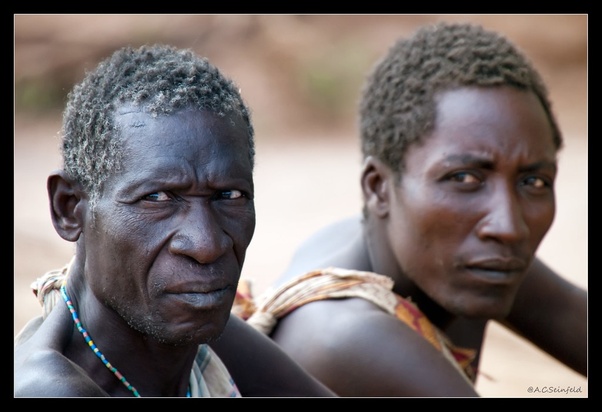 Were the ancient north Africans black?
Were the ancient north Africans black?
YES. Blacks were in North Africa first. An ancient people related to the Hadza people of Tanzania, were the first North Africans and Eurasians - also confirmed by Harvard Medical School and they are a black African people with Y-DNA Haplogroup B. They were the first people to settle in North Africa along with the Haplogroup A Nilotics.
Haplogroup B also settled in the Middle East, Europe, Asia, and the Pacific Islands probably around 65, 000 - 100,000 years ago and their genetic fingerprint are found in ALL modern humans.
Prior to 3,000 - 5,000 years ago, there were no whites in Africa and everybody in Africa was lactose intolerant. White skin came with the SLC24A5 mutation that took place 10,000 years ago in Anatolia. This gene is now carried by present-day North Africans and Middle Easterners and was inherited from one human that lived 10,000 years ago somewhere in Anatolia and later showed up in Africa probably between 3,000 - 5,000 years ago.
The first whites that entered Africa were known as the ‘Libyan Berbers’ and much much later, the Hyksos Semites came. These people slowly made their way down to North West Africa and diluted into the gene pool. They entered some countries in Africa through war, whilst other countries were entered via cultural assimilation and admixture.
Who were the Libyan Berbers?
The Libyan Berbers are well recorded in history, and the ancestral lineage is from Anatolia, West Asia. They have cultural affiliations with East Europeans, the Basque people in Spain, and the Scandinavians, however, the bulk of their ancestry is from Anatolia (West Asia) - they dress like Turkish people and even look like them - because they ARE them. However, they have diluted into the E1b1b black African gene pool through thousands of years of admixture.
But make no mistake, there were already native blacks always living in North Africa long before the arrival of the Libyan Berbers which I will identify later.
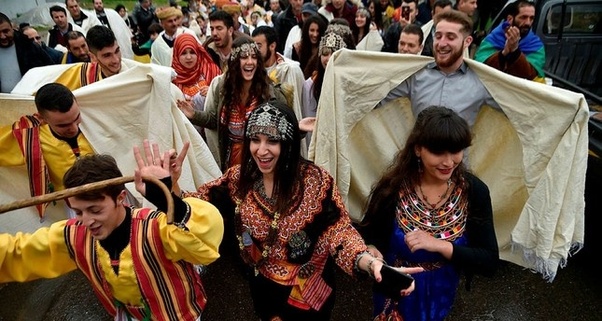 Although the North African Berbers like to claim that they are ‘different’ from Arabs, recent genetic studies say otherwise. In fact, there isn’t much difference between present-day North Africans and Arabs.
Quote from the study
‘’Though no differences have been found in uniparental and classical markers between Berbers and Arabs, the two main ethnic groups in the region, the scanty genomic data available have highlighted the singularity of Berbers. We characterize the genetic heterogeneity of North African groups, focusing on the putative differences of Berbers and Arabs, and estimate migration dates. We analyze genome-wide autosomal data in five Berber and six Arab groups, and compare them to Middle Easterns, sub-Saharans, and Europeans. Haplotype-based methods show a lack of correlation between geographical and genetic populations, and a high degree of genetic heterogeneity, without strong differences between Berbers and Arabs.’’
As you can see, the Berber identity is simply a ‘tribal’ and ‘cultural’ identity, not a racial one.
Although the North African Berbers like to claim that they are ‘different’ from Arabs, recent genetic studies say otherwise. In fact, there isn’t much difference between present-day North Africans and Arabs.
Quote from the study
‘’Though no differences have been found in uniparental and classical markers between Berbers and Arabs, the two main ethnic groups in the region, the scanty genomic data available have highlighted the singularity of Berbers. We characterize the genetic heterogeneity of North African groups, focusing on the putative differences of Berbers and Arabs, and estimate migration dates. We analyze genome-wide autosomal data in five Berber and six Arab groups, and compare them to Middle Easterns, sub-Saharans, and Europeans. Haplotype-based methods show a lack of correlation between geographical and genetic populations, and a high degree of genetic heterogeneity, without strong differences between Berbers and Arabs.’’
As you can see, the Berber identity is simply a ‘tribal’ and ‘cultural’ identity, not a racial one.
So were the Libyan Berbers the first in North Africa?
No! North African white Berbers commonly use this argument that a white-skinned Cro-magnon type man called ‘Mechta Afalou’ lived in North Africa and that’s who they descend from. However, there is no evidence that they directly descended from this man - especially, considering the huge amount of migrations that took place in North Africa from Turks, Romans, Greeks etc.
In fact, the 2018 study on the 15,000-year-old ancient remains of the ancient Iberomarusians buried in Northern Morocco tells a completely different story. These ancient individuals carried the E1b1b genes but the SLC24A5 depigmentation genes found in the present-day North African whites did not show up, even though the same MtDNA and Y-DNA genes showed up (U6 and E1b1b). This is a further testament that the white skin found in the Berbers today would have arrived via a more recent migration to the Maghreb.
In that study, they also discovered a ‘ghost’ archaic gene carried by the Iberomaurusians which is now only found in Sub Saharan Africans, specifically West Africans. At first, the scientists could not ascertain where it came from, but later, another recent study from the Dzudzuana caves in Georgia revealed that West Africans (represented by the Yoruba) carry 12% DNA passed down from a Taforalt/Iberomarusian related group.
So, pretty much, the unique combination of all the genes found in the ancient Iberomaurusians (The Berber marker Y-DNA E1b1b/mtDNA U6, the Middle Eastern genes, the Hadza genes (haplogroup B), and the ‘ghost’ genes) closely matches the Hausa, Fulani, Yorubas, Mandinka, and Soninke peoples more than it matches the present-day North Africans. The Hausa people in Nigeria carry every single one of these genes and the Mande speaking tribes had a whopping 5.8% archaic genes.
This is further testament to the fact that the first West Eurasians came back to Africa as black. So, E1b1b is African to the core and the Iberomaurusians were black people.
Hausa Nigerian couple:
 How Did This Happen?
After haplogroup A and B emerged, the early anatomically modern humans of the CT haplogroup were probably mixing with both Nilotic and Hadza women in North-East Africa. It is probably from this admixture the Haplogroup DE and E carriers emerged within Africa. This admixture might have taken place as far back a 50,000 years ago and would have migrated to the Middle East and out of Africa and into Europe via the Y-DNA E1b1b men. However, the rest of the Y-DNA E family never really left Africa. Bear in mind that CT/DE/E1b1b was the second migration out of Africa. The first migration would have taken place many years earlier when Haplogroup B left for Asia - the continent where C and D were formed from admixture with Denisovans.
Over the course of thousands of years, E1b1b re-entered Africa from the Middle East, settling in Egypt and North East Africa and battling their E1b1a / Nilotic brothers in Sudan for gold and fertile land. Eventually, cultural assimilation took place between the two and they all ended up in West Africa - caused by both the spread of the Sahara, desertification, and the later foreign invaders (Lybians and Hyksos).
How Did This Happen?
After haplogroup A and B emerged, the early anatomically modern humans of the CT haplogroup were probably mixing with both Nilotic and Hadza women in North-East Africa. It is probably from this admixture the Haplogroup DE and E carriers emerged within Africa. This admixture might have taken place as far back a 50,000 years ago and would have migrated to the Middle East and out of Africa and into Europe via the Y-DNA E1b1b men. However, the rest of the Y-DNA E family never really left Africa. Bear in mind that CT/DE/E1b1b was the second migration out of Africa. The first migration would have taken place many years earlier when Haplogroup B left for Asia - the continent where C and D were formed from admixture with Denisovans.
Over the course of thousands of years, E1b1b re-entered Africa from the Middle East, settling in Egypt and North East Africa and battling their E1b1a / Nilotic brothers in Sudan for gold and fertile land. Eventually, cultural assimilation took place between the two and they all ended up in West Africa - caused by both the spread of the Sahara, desertification, and the later foreign invaders (Lybians and Hyksos).
Who are the descendants of the Ibermaurusians?
The Iberomaurusians are not the direct ancestors of the present-day North Africans, because the present-day North Africans lack the unique cocktail of all the genes found in the Iberomarusian remains. There was a rather archaic gene discovered in the Iberomaurusians which points to West Africa. West Africans, particularly those in Morocco, Western Sahara, Senegal, Mauritania, and Mali, are the ones who carry these ancient admixtures and the history of Ancient North Africa including Ancient Egypt, the animistic cultural beliefs were spun from these people - Songhai, Dogon, Serer, Wolof, Soninke, Hausa, Igbo, Yoruba, Fulani, Mandinka, Ashanti - all the tribes of West Africa. Although most are now Muslim, many still practice those ancient beliefs and until this day, the arts are still in West Africa (I will show this later).
On the contrary, present-day North Africans show more newly acquired West Eurasian and European input in their genes that came from a more recent wave of whites that migrated from Europe and West Asia that took place over the last 2–3,000 years.
On the contrary, present-day North Africans show more newly acquired West Eurasian and European input in their genes that came from a more recent wave of whites that migrated from Europe and West Asia that took place over the last 2–3,000 years.
What does DNA say?
Present-day North Africans are trying to claim that they descend directly from ‘Mechta Afalou’ but there is no evidence of this.
North Africans also like to use the argument that the indigenous Berber component MtDNA U6 and E1b1b belongs to the white-skinned Berbers and Europeans. However, they ignore the fact that other Africans also show a connection to those lineages like the Hausa and Fulani people in Nigeria.
They also like to claim that the indigenous North Africans were white and the Sahara separated them from other Africans, forgetting the Nilotic and Hadza peoples always lived above the Sahara when it was green. African Hunter-Gatherers even lived as far as Europe. What's more, the Sahara was green at one point, and humans could easily cross over.
They also like to put up computer-generated images (like the below) of Mechta Afalou to support their claim. There is no evidence whatsoever that the Mechta Afalou had this skin color in the image below. In fact, the recent 2018 study on the 15,000-year-old ancient remains of the Iberomarusians in North Africa that showed that the ancient E1b1b individuals had the following characteristics;
“Phenotypic analysis was performed on four of the Taforalt individuals with higher genomic coverage. The Taforalt individuals tested did NOT carry either of the derived SLC24A5 alleles associated with lighter skin color, the derived OCA2allele associated with blue eye color, or the derived MCM6 allele associated with lactase persistence. However, they were found to carry the ancestral SLC24A4 allele associated with dark eye color.’’
Haplogroup E is derived from DE and is an African lineage and the study clearly proves that both the mixed-race combination of E1b1b and MtDNA U6 was dark-skinned before it was white.
Yet, white North Africans still think that the ancient North Africans looked like this;
 On the contrary, the latest DNA studies show that they would have more or less resembled this image below - minus the blue eyes -Source; Ancient DNA sheds light on the origin of Europeans
“The results pointed to a Middle Eastern origin for Cheddar Man, suggesting that his ancestors would have left Africa, moved into the Middle East and later headed west into Europe, before eventually crossing the ancient land bridge called Doggerland which connected Britain to continental Europe.”
On the contrary, the latest DNA studies show that they would have more or less resembled this image below - minus the blue eyes -Source; Ancient DNA sheds light on the origin of Europeans
“The results pointed to a Middle Eastern origin for Cheddar Man, suggesting that his ancestors would have left Africa, moved into the Middle East and later headed west into Europe, before eventually crossing the ancient land bridge called Doggerland which connected Britain to continental Europe.”
Who were the first north Africans?
The first West Asians would have arrived in Africa black-skinned or mixed race. How their genes were acquired by the white Libyan Berbers that arrived much later was through admixture and assimilation. There were many different waves of white-skinned Europeans and West Asians that entered North Africa at a much later date. Nonetheless, they were not the same people as the original E1b1b carriers - the SLC14A5 skin colour alleles would have differentiated them.
The last possible scenario could be that black African men that carried E1b1b left Africa and mixed with West Asian women of the MtDNA U6 haplogroup somewhere in the Near East and the admixed population came back to Africa. This would make more sense as MtDNA U6 is usually linked with European women that belong to the Y-DNA R1a/R1b.
E1b1b, on the other hand, is clearly an African lineage. This would, therefore, mean that the first North African Berbers were mixed race.
What’s even more interesting is that 47% OF Hausa people in Nigeria carry R1b, with some minor A, B, E1b1b, and E1b1a. But Hausa people still look very black-skinned despite having R1b.
Hausa People - Nigeria
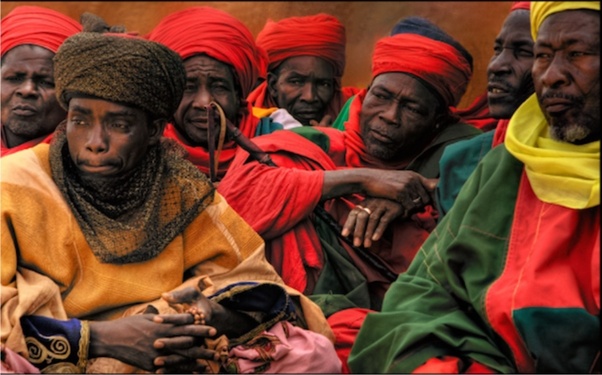
What else does DNA say?
Regardless of who Mechta Afalou was, the archaic humans found in West Africans are uniquely African and are very distinct from the archaic genes of the Australian Aborigines (Denisovans) or Eurasians (Neanderthals) and the Cro Magnon. Hence why genetic scientists have labeled them as a ‘Pan African’ archaic humans.
In other words, Africans may have already admixed with their own unique archaic humans and defined their own unique gene pool before migrating out of Africa. This unique combination would have made its way out of Africa via the Y-DNA E1b1b lineage as mentioned earlier.
Studies also confirmed that the Iberomaurusians also passed on genes to the Natufians who were also E1b1b. Funny enough, a very similar same phenotype is found in Yemen like this man.
 Earlier, I mentioned about the Mandinka having the highest archaic genes of all Africans - 5.8% - look at this Mandinka footballer Pappiss Cisse from Mali below - the Mandinka are some of the blackest of all West Africans and bear a similar resemblance to the South Sudanese Nilotics - who are the blackest of all humans.
Mandinka, themselves, show Nilotic heritage - they carry various Y-DNA’s that include A1a - it is very likely these archaic humans would have mixed with both Nilotic Dinka and Hadza women. It could also be where the Mandinka got their name - from the ‘Dinka’ in South Sudan.
Earlier, I mentioned about the Mandinka having the highest archaic genes of all Africans - 5.8% - look at this Mandinka footballer Pappiss Cisse from Mali below - the Mandinka are some of the blackest of all West Africans and bear a similar resemblance to the South Sudanese Nilotics - who are the blackest of all humans.
Mandinka, themselves, show Nilotic heritage - they carry various Y-DNA’s that include A1a - it is very likely these archaic humans would have mixed with both Nilotic Dinka and Hadza women. It could also be where the Mandinka got their name - from the ‘Dinka’ in South Sudan.

Where do the present-day Berbers fit in?
As the SLC24A5 gene that arrived very late in African history was inherited from one human (which matured in Anatolia), then that is evidence of a separate migration at a much much later date. The present-day Berbers in North Africa arrived via Libya and settled in Egypt. By the time the Libyans had arrived, the Ancient Egyptian civilization was already in full swing.
The Libyan nomadic Berbers then continued their migration in the Westerly direction of the already existing admixed black-skinned Iberomarusians who were the ancestors of the Ancient Egyptians and they diluted into the gene pool.
Who were the Ibermaurusians?
As mentioned earlier, the Hadza were ancestral to the Iberomaurusians. Much of the genes of the Iberomauriusians were formed from an admixture of archaic humans with the Hadza/Mota/Nilotic peoples as well as Middle Eastern proto-Berber component.
Did the Ibermaurusians start the ancient Egyptian civilisation?
The Egyptian civilization was spun by the spirituality of the Iberomaurusian people which was then passed on to their descendants. However, Ibermaursians were quite distinct from the Ancient Egyptians. By the time the SLC24A5 Libyan Berbers carriers arrived, the archaic Africans were already admixed with the Hadza and Nilotics for well over 50,000 years and became the ancestors of the present-day West Africans.
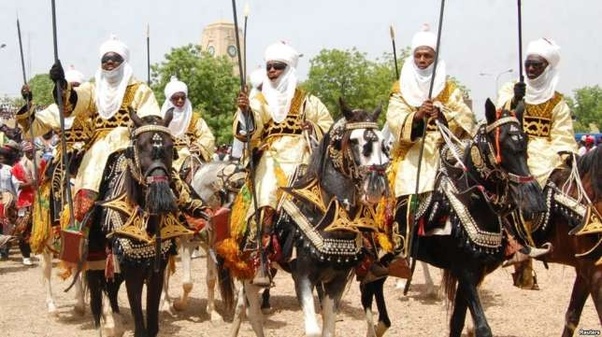 Dhar Tichitt and the Ibermaurusians
Most of the descendants of the ancient Egyptians ended up in Mauritania, just like the Libyan Berbers who also ended up in Morocco and Northern Mauritania. Mauritanian history is well-recorded and the Libyan Berbers/Hyksos entered into the Iberomaurusian culture existing in Mauritania as recent as the 3rd century. Hence, the reason why the unique admixture of the Iberomaurusian genes found in the Taforalt study is not found in present-day North Africans or Middle Easterners.
Dhar Tichitt neolithic settlement
Dhar Tichitt and the Ibermaurusians
Most of the descendants of the ancient Egyptians ended up in Mauritania, just like the Libyan Berbers who also ended up in Morocco and Northern Mauritania. Mauritanian history is well-recorded and the Libyan Berbers/Hyksos entered into the Iberomaurusian culture existing in Mauritania as recent as the 3rd century. Hence, the reason why the unique admixture of the Iberomaurusian genes found in the Taforalt study is not found in present-day North Africans or Middle Easterners.
Dhar Tichitt neolithic settlement
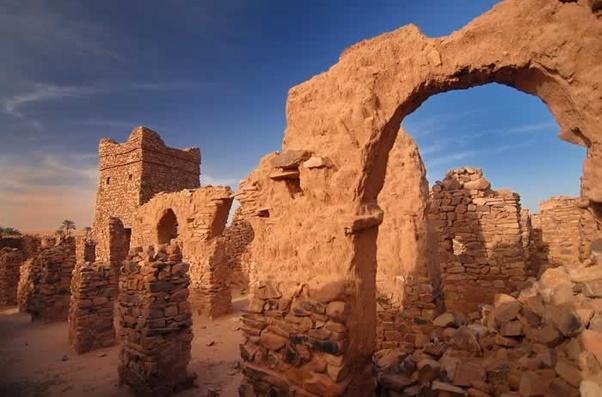 The Iberomarusians were pretty much Nilo Saharans and were also responsible for Dhar Tichitt neolithic settlement in Mauritania which I talked about earlier. These Neolithic settlements were advanced and the burial practices were the same as Ancient Egypt. They originally developed a semi-nomadic lifestyle, based on horse and cattle.
Berbers regularly raided Dhar Tichitt and eventually invaded the city. The white Arabs and North African Berber later diluted into the ancient Mauritanian gene pool and settled in Northern Mauritania.
How did horses come to West Africa?
The horses of the Iberomaurusians are indigenous to Africa and not due to foreign imports - some strains of horses are descendants of the ancient North African Barb horses that were used by the black-skinned ancient Iberomausians that lived in the North African region before migrating to West Africa. Horse riding had been part of West African history for well over 5,000 years
The Ibermaurusians eventually made their way down to Northern Nigeria for greener pastures or due to foreign invasions by Libyan Berber and Arabs (Almoravids), as well as due to desertification. They went by horse to West Africa and the image below shows Neolithic rock art depicting their house culture - these were found at the Dhar Tchitt neolithic settlement in Southern Mauritania - 4, 000 - 2,000 BC.
‘’Finger-painted scenes of mounted and unmounted horses in rows are common. Grotte des Écritures features herdsmen whilst M’treoka features incised boulders with engravings. The rock art covers a time from the Hunters Period: 7,000 – 2,500 BCto the Camel Period: about 100 BC.’’
Source: Trust for African Rock Art
According to the British Museum ‘’Traditional chronologies for Saharan rock art areas tend to place depictions of ridden horses chronologically after those of horses and chariots, and in general use horse depictions to categorise regional stylistic periods of rock art according to broad date boundaries. As such, in most places, the ‘horse’ rock art period is usually said to cover about a thousand years from the end of the 2nd millennium BC. It is then considered to be succeeded by a ‘camel’ period, where the appearance of images of dromedaries – known only to have been introduced to the eastern Sahara from Arabia at the end of the 1st century BC – reflects the next momentous influx of a beast of burden to the area and thus a new dating parameter (read more about depictions of camels in the Sahara).
People often assume that horses came to Africa via the present-day white Berbers and Arabs, but in fact, horses were already there. Horses have been in West Africa since 4,000 BC or even as far as 7,000 BC and most of the rock art in Mauritania depicting horses were found in South Eastern Mauritania, an area where the present-day Berbers and Arabs never settled.
The current Berbers and Arabs of West Asian descent actually arrived on camels. What’s more, Dhar Tichitt was destroyed upon the arrival of Libyan Berbers and Arabs in the 3rd century - So, neither of those groups were the source of horses or the civilizations in West Africa.
West African Horsemen
The Iberomarusians were pretty much Nilo Saharans and were also responsible for Dhar Tichitt neolithic settlement in Mauritania which I talked about earlier. These Neolithic settlements were advanced and the burial practices were the same as Ancient Egypt. They originally developed a semi-nomadic lifestyle, based on horse and cattle.
Berbers regularly raided Dhar Tichitt and eventually invaded the city. The white Arabs and North African Berber later diluted into the ancient Mauritanian gene pool and settled in Northern Mauritania.
How did horses come to West Africa?
The horses of the Iberomaurusians are indigenous to Africa and not due to foreign imports - some strains of horses are descendants of the ancient North African Barb horses that were used by the black-skinned ancient Iberomausians that lived in the North African region before migrating to West Africa. Horse riding had been part of West African history for well over 5,000 years
The Ibermaurusians eventually made their way down to Northern Nigeria for greener pastures or due to foreign invasions by Libyan Berber and Arabs (Almoravids), as well as due to desertification. They went by horse to West Africa and the image below shows Neolithic rock art depicting their house culture - these were found at the Dhar Tchitt neolithic settlement in Southern Mauritania - 4, 000 - 2,000 BC.
‘’Finger-painted scenes of mounted and unmounted horses in rows are common. Grotte des Écritures features herdsmen whilst M’treoka features incised boulders with engravings. The rock art covers a time from the Hunters Period: 7,000 – 2,500 BCto the Camel Period: about 100 BC.’’
Source: Trust for African Rock Art
According to the British Museum ‘’Traditional chronologies for Saharan rock art areas tend to place depictions of ridden horses chronologically after those of horses and chariots, and in general use horse depictions to categorise regional stylistic periods of rock art according to broad date boundaries. As such, in most places, the ‘horse’ rock art period is usually said to cover about a thousand years from the end of the 2nd millennium BC. It is then considered to be succeeded by a ‘camel’ period, where the appearance of images of dromedaries – known only to have been introduced to the eastern Sahara from Arabia at the end of the 1st century BC – reflects the next momentous influx of a beast of burden to the area and thus a new dating parameter (read more about depictions of camels in the Sahara).
People often assume that horses came to Africa via the present-day white Berbers and Arabs, but in fact, horses were already there. Horses have been in West Africa since 4,000 BC or even as far as 7,000 BC and most of the rock art in Mauritania depicting horses were found in South Eastern Mauritania, an area where the present-day Berbers and Arabs never settled.
The current Berbers and Arabs of West Asian descent actually arrived on camels. What’s more, Dhar Tichitt was destroyed upon the arrival of Libyan Berbers and Arabs in the 3rd century - So, neither of those groups were the source of horses or the civilizations in West Africa.
West African Horsemen

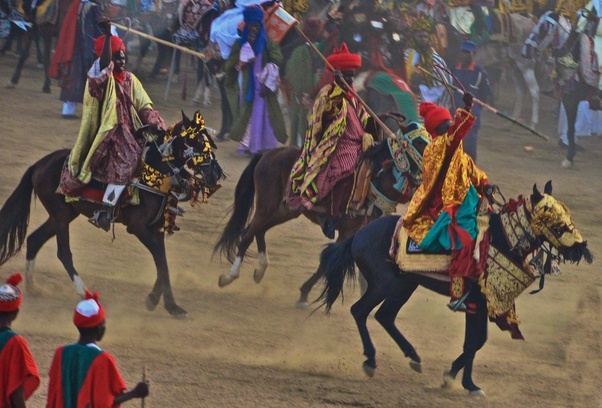
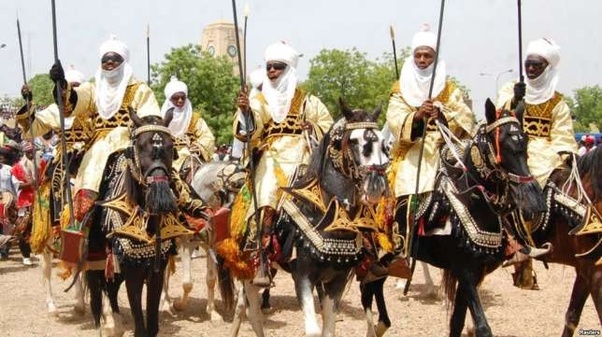 Who were the cattle herdsmen?
Iberomaurusian Nilo Saharan people were also known across Africa for their cattle culture. Rock paintings are found all over caves in North of cattle and livestock. The Sanga cattle are the modern relatives of the Ancient Egyptian cattle and they are found amongst the Nilotic people in East Africa, the Fulani people in West Africa and the Tutsi and Zulu peoples in Central and Southern Africa.
Who were the cattle herdsmen?
Iberomaurusian Nilo Saharan people were also known across Africa for their cattle culture. Rock paintings are found all over caves in North of cattle and livestock. The Sanga cattle are the modern relatives of the Ancient Egyptian cattle and they are found amongst the Nilotic people in East Africa, the Fulani people in West Africa and the Tutsi and Zulu peoples in Central and Southern Africa.
The cattle herders also migrated down to West Africa - the rock paintings below depict them. They no longer exist in North Africa. They have moved South to East and West Africa with their cattle.


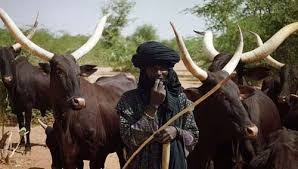 Who were the ancient Egyptians?
As mentioned. the ancients of Africa were all black-skinned until between 3,000 - 5,000 years ago when the white gene SLC24A5 showed up in Africa. The white Libyan and Hyksos migrated from the Caucasus to an already existing ancient civilization in Egypt and diluted into the already existing Y-DNA haplogroup E gene pool that was carried by the ancient black North Africans. The only reason why the present-day, white-skinned North Africans carry the Y-DNA E is because their male ancestors were black. However, the bulk of their ancestry is actually from the white skinned-West Eurasian migrants. The Copts are probably an admixed group but look white because of heavy West Eurasian admixture.
By the time ancient Egypt had become heavily West Eurasian, the history and the culture were fast deteriorating. The West Eurasian Arabs were the ones who destroyed the Ancient Egyptian civilization and brought it to the ground.
To be honest, there isn’t much that links Modern-day North African culture back to Ancient Egyptians except the E1b1b DNA. Even so, there is more of a possibility that the ancient Egyptians were actually E1b1a. The only Pharaohnic DNA ever released was Ramses 3rd and he was reported in a study to carry E1b1a. In fact, all the culture is in the South of the Sahara - more specifically in West Africa, as you will see later.
Animistic cultures and ancient Egypt?
Kemeticism/Animism is all about living in the rhythm of your natural environment. There are various ‘gods’ or pantheons, but there is always one supreme God. One common theme you will notice with tribes around the world that practice Kemticism is that they all carry feathers in their hair. All the way from Papua New Guinea to the Native Americans, to the Yorubas in West Africa - in every Kemetic culture, you will find the Serpent God and the feathers. Although the feathers have a different meaning depending on the tribe you come into contact with, nonetheless, they have common grounds and go back to one ancestor.
Ancient Egyptian Feather Headdress
Who were the ancient Egyptians?
As mentioned. the ancients of Africa were all black-skinned until between 3,000 - 5,000 years ago when the white gene SLC24A5 showed up in Africa. The white Libyan and Hyksos migrated from the Caucasus to an already existing ancient civilization in Egypt and diluted into the already existing Y-DNA haplogroup E gene pool that was carried by the ancient black North Africans. The only reason why the present-day, white-skinned North Africans carry the Y-DNA E is because their male ancestors were black. However, the bulk of their ancestry is actually from the white skinned-West Eurasian migrants. The Copts are probably an admixed group but look white because of heavy West Eurasian admixture.
By the time ancient Egypt had become heavily West Eurasian, the history and the culture were fast deteriorating. The West Eurasian Arabs were the ones who destroyed the Ancient Egyptian civilization and brought it to the ground.
To be honest, there isn’t much that links Modern-day North African culture back to Ancient Egyptians except the E1b1b DNA. Even so, there is more of a possibility that the ancient Egyptians were actually E1b1a. The only Pharaohnic DNA ever released was Ramses 3rd and he was reported in a study to carry E1b1a. In fact, all the culture is in the South of the Sahara - more specifically in West Africa, as you will see later.
Animistic cultures and ancient Egypt?
Kemeticism/Animism is all about living in the rhythm of your natural environment. There are various ‘gods’ or pantheons, but there is always one supreme God. One common theme you will notice with tribes around the world that practice Kemticism is that they all carry feathers in their hair. All the way from Papua New Guinea to the Native Americans, to the Yorubas in West Africa - in every Kemetic culture, you will find the Serpent God and the feathers. Although the feathers have a different meaning depending on the tribe you come into contact with, nonetheless, they have common grounds and go back to one ancestor.
Ancient Egyptian Feather Headdress
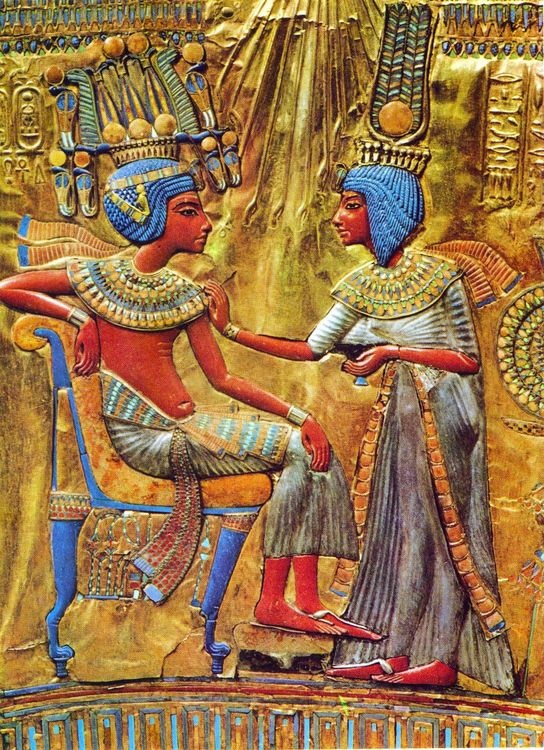 Nilotics Feather Headress
Nilotics Feather Headress
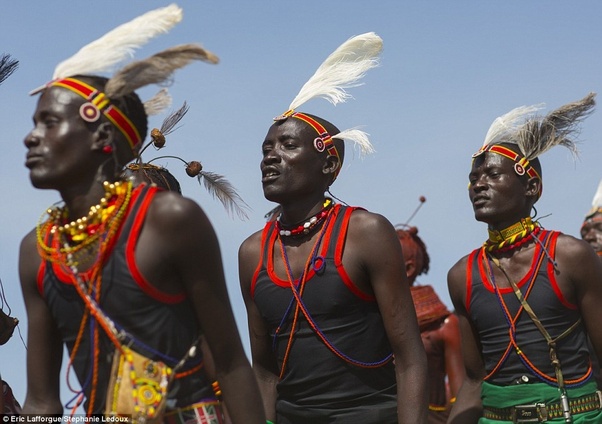 Melanesians Feather Headress
Melanesians Feather Headress
 Native Americans Feather Headress
Native Americans Feather Headress
 Non-animistic cultures?
The present-day Egyptians are mostly West Eurasian migrants from Anatolia who didn’t have much of a Kemetic culture but rather a Barbarian one. They migrated to Egypt and settled in the lands of the Hamitics, as well as the Hebrews. Upon arriving, many adopted the culture of the Hamitic blacks in ancient North Africa and diluted into the gene pool, whilst others adopted an Abrahamic/Hebrew culture that spread from the blacks in Southern Yemen (Natufians). The Allah God told them not to worship statues and idols like those of the Hamitics.
Over time, as more and more West Eurasians arrived via the Middle East, the original Kemetic culture was replaced to an Abrahamic one. You can identify their West Eurasians origins by the silver Turkish style jewellery they wear and the headscarves they use to cover their heads which is a classic West Eurasian/East European dress style.
Non-animistic cultures?
The present-day Egyptians are mostly West Eurasian migrants from Anatolia who didn’t have much of a Kemetic culture but rather a Barbarian one. They migrated to Egypt and settled in the lands of the Hamitics, as well as the Hebrews. Upon arriving, many adopted the culture of the Hamitic blacks in ancient North Africa and diluted into the gene pool, whilst others adopted an Abrahamic/Hebrew culture that spread from the blacks in Southern Yemen (Natufians). The Allah God told them not to worship statues and idols like those of the Hamitics.
Over time, as more and more West Eurasians arrived via the Middle East, the original Kemetic culture was replaced to an Abrahamic one. You can identify their West Eurasians origins by the silver Turkish style jewellery they wear and the headscarves they use to cover their heads which is a classic West Eurasian/East European dress style.
 There is absolutely nothing in modern-day North African culture that remotely resembles any of the ancient beliefs in ancient Egypt. Pretty much all the ancient artifacts were dug up by foreign Egyptologists.
Only in Sub Saharan Africa are the true Ancient Egyptian beliefs, statues and arts still found. The dress style of the Ancient Egyptians is found amongst the Nilotics - e.g the Masai necklace (a Nilotic peoples). The ancient arts are mostly found amongst the Yoruba in Nigeria. This is because the ancient Egyptians were Nilotic-Saharan’s that migrated to West Africa and Sub-Saharan Africa with their culture and art.
There are thousands of ancient artifacts in West Africa resembling all the ancient Egyptian spirituality which these Eurocentric Egyptologists are deliberately ignoring. No artifact in modern North day Africa remotely resembles the ancient spirituality of Egypt except from what’s been dug up by foreign Egyptologists. They can’t even properly interpret what the ancient sculptures or tools were used for.
Masaai Ancient Nilotic Necklace
There is absolutely nothing in modern-day North African culture that remotely resembles any of the ancient beliefs in ancient Egypt. Pretty much all the ancient artifacts were dug up by foreign Egyptologists.
Only in Sub Saharan Africa are the true Ancient Egyptian beliefs, statues and arts still found. The dress style of the Ancient Egyptians is found amongst the Nilotics - e.g the Masai necklace (a Nilotic peoples). The ancient arts are mostly found amongst the Yoruba in Nigeria. This is because the ancient Egyptians were Nilotic-Saharan’s that migrated to West Africa and Sub-Saharan Africa with their culture and art.
There are thousands of ancient artifacts in West Africa resembling all the ancient Egyptian spirituality which these Eurocentric Egyptologists are deliberately ignoring. No artifact in modern North day Africa remotely resembles the ancient spirituality of Egypt except from what’s been dug up by foreign Egyptologists. They can’t even properly interpret what the ancient sculptures or tools were used for.
Masaai Ancient Nilotic Necklace
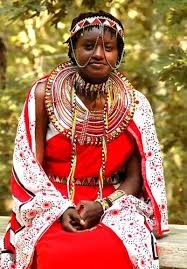 Ancient Egyptian Snake Helmet
Yoruba Snake Helmet
Ancient Egyptian Rams head
Ancient Egyptian Snake Helmet
Yoruba Snake Helmet
Ancient Egyptian Rams head
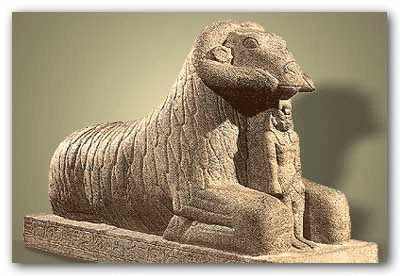 Yoruba Rams Head
Yoruba Rams Head
 9
9
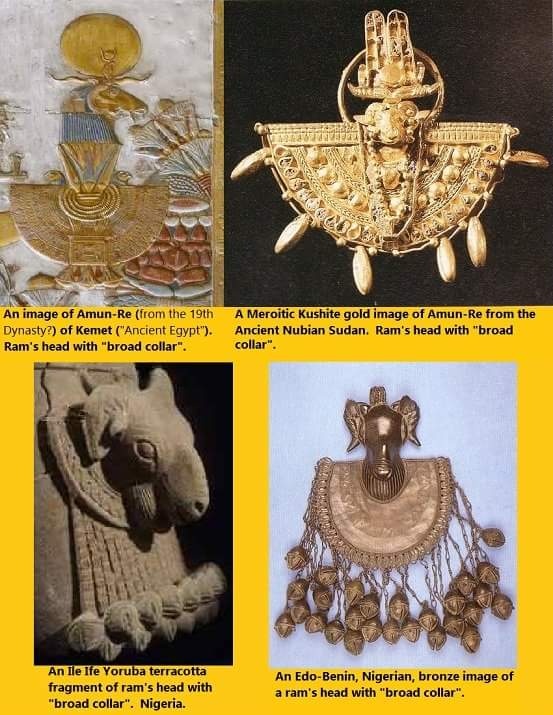 Figure of Ancient Egyptian God ‘Bes’ - Note the skull on the neck
Figure of Ancient Egyptian God ‘Bes’ - Note the skull on the neck
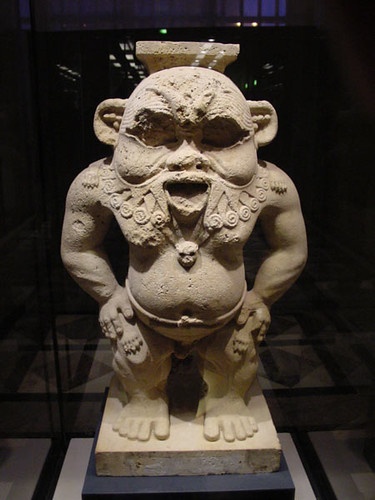 Yoruba - Child of Obatala (Note the skull on the neck)
Source: African Art
The Egyptian voodoo/ magic stick
Yoruba - Child of Obatala (Note the skull on the neck)
Source: African Art
The Egyptian voodoo/ magic stick
 Yoruba voodoo/ magic stick
Yoruba voodoo/ magic stick
 Ancient Egyptian Cow Hathor Goddess of puberty - note the ears like a cow
Ancient Egyptian Cow Hathor Goddess of puberty - note the ears like a cow
 Panya Ngome Congolese mask - Symbol of Puberty - This mask, used by the Eastern Pende people of the DRC is known as panya ngombe and represents a buffalo, symbol of authority and dignity. It is worn only during the mukanda initiation of adolescent boys after their circumcision, to gather donations to cover the cost of the celebration that took place after the initiation period.
Panya Ngome Congolese mask - Symbol of Puberty - This mask, used by the Eastern Pende people of the DRC is known as panya ngombe and represents a buffalo, symbol of authority and dignity. It is worn only during the mukanda initiation of adolescent boys after their circumcision, to gather donations to cover the cost of the celebration that took place after the initiation period.

The cattle herders also migrated down to West Africa - the rock paintings below depict them. They no longer exist in North Africa. They have moved South to East and West Africa with their cattle.




New comments are not allowed.